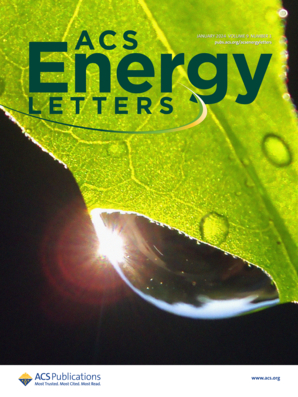Regulating the Oxygen Evolution Mechanism through In Situ Reconstruction of Ru-Modified Manganese Oxybromide
IF 19.3
1区 材料科学
Q1 CHEMISTRY, PHYSICAL
引用次数: 0
Abstract
Regulating the oxygen evolution reaction (OER) mechanism presents a promising yet challenging approach to address the performance-stability trade-off of acidic water oxidation catalysts. Here we demonstrate the regulation of the OER mechanism through in situ surface reconstruction of manganese oxybromides (MOB) catalysts modified with single-atom ruthenium (Ru-MOB). In situ Raman spectroscopy reveals that Ru incorporation intensifies the inherent, reversible surface reconstruction of MOB, resulting in the formation of a γ-MnO2 layer with an onset potential approximately 100 mV lower. Various operando/in situ characterizations and theoretical calculations show that the reconstructed Ru-MOB significantly suppresses the lattice oxygen mechanism while simultaneously enhancing the adsorbate evolution mechanism. In an electrochemical cell, the reconstructed Ru-MOB drives acidic OER with an overpotential about 90 mV lower at 10 mA cm–2 compared to pure MOB, and it shows negligible performance degradation for over 1400 h. Our work offers a design strategy for the future development of acidic OER catalysts.

ru修饰的氧化溴化锰原位重构调控析氧机理
调节析氧反应(OER)机制是解决酸性水氧化催化剂性能稳定性权衡的一个有希望但又具有挑战性的方法。本文通过单原子钌修饰的氧化溴化锰(MOB)催化剂(Ru-MOB)的原位表面重构,证明了OER机理的调控。原位拉曼光谱显示,Ru的掺入增强了MOB固有的、可逆的表面重构,导致γ-MnO2层的形成,其起始电位大约低100 mV。各种操作/原位表征和理论计算表明,重构的Ru-MOB显著抑制了晶格氧机制,同时增强了吸附质演化机制。在电化学电池中,与纯MOB相比,重构的Ru-MOB在10 mA cm-2下驱动酸性OER的过电位降低了约90 mV,并且在超过1400小时的时间内性能下降可以忽略。我们的工作为酸性OER催化剂的未来发展提供了设计策略。
本文章由计算机程序翻译,如有差异,请以英文原文为准。
求助全文
约1分钟内获得全文
求助全文
来源期刊

ACS Energy Letters
Energy-Renewable Energy, Sustainability and the Environment
CiteScore
31.20
自引率
5.00%
发文量
469
审稿时长
1 months
期刊介绍:
ACS Energy Letters is a monthly journal that publishes papers reporting new scientific advances in energy research. The journal focuses on topics that are of interest to scientists working in the fundamental and applied sciences. Rapid publication is a central criterion for acceptance, and the journal is known for its quick publication times, with an average of 4-6 weeks from submission to web publication in As Soon As Publishable format.
ACS Energy Letters is ranked as the number one journal in the Web of Science Electrochemistry category. It also ranks within the top 10 journals for Physical Chemistry, Energy & Fuels, and Nanoscience & Nanotechnology.
The journal offers several types of articles, including Letters, Energy Express, Perspectives, Reviews, Editorials, Viewpoints and Energy Focus. Additionally, authors have the option to submit videos that summarize or support the information presented in a Perspective or Review article, which can be highlighted on the journal's website. ACS Energy Letters is abstracted and indexed in Chemical Abstracts Service/SciFinder, EBSCO-summon, PubMed, Web of Science, Scopus and Portico.
 求助内容:
求助内容: 应助结果提醒方式:
应助结果提醒方式:


